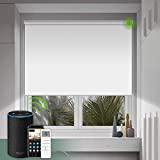There are now several options when it comes to shading your windows electronically. You can purchase remote or smart blinds, smart tint and even smart windows with electric shading.
For myself, I wanted to keep the traditional look of regular blinds due to my home decor not being that contemporary. If your home or condo has a more modern design with giant panes of glass, electronic window tint may be your best option. If you have the money to spend, then you may opt for smart windows.
Whatever the option may be, they all seemed to be better to me than claustrophobia-inducing, heavy curtains. Those options are the only ones that completely block out light (not every option on this list has that capability, though).
Of course, you can still use curtains, but they can be more for decor than blocking light or keeping people from seeing in your home. This article is intended to have everything you should know about smart windows and privacy glass for your home.
Windows with Electric Shading
Windows that shade electronically, electronic window shades, smart window film, and smart glass all fall under the category of windows with electric shading. These shading options allow you to shade your home from sunlight and UV rays while providing privacy.
Electric shading can be operated through a button, a remote control, voice activation, or any other automatic working system that uses an electric component or motor vs. having to open and close curtains or blinds manually.
While you might not think of these options for your entire house, just think of the rooms where you would find in most beneficial. Maybe the living room gets a lot of sun during the first half of the day? Smart windows would be able to adjust to the light and temperature. Maybe you want smart shades for the rooms facing the street and your bedroom, so you can program them to close when the sun goes down for privacy?
For those rooms, these options are ideal. There are a few different types of this electric shading. Let’s break them down, so you can make the most educated choice for your home:
| Image | Title | Works With | Price | Buy |
|---|---|---|---|---|
Top Top Top |
Yoolax Motorized Blind Shade for Window with Remote Control Smart Blind Shade Compatible with Alexa Motorized Roller Shade Blackout Battery Solar Powered Blind Custom up 98”W X 138”H (Vinyl-White) | Alexa, Google Home | View on Amazon | |
 Top Top |
Yoolax Motorized Smart Blind for Window with Remote Control, Automatic Blackout Roller Shade Compatible with Alexa, Child Safety Rechargeable Battery Blind with Valance(Vinyl-Dark Grey) | Alexa, Google Home, SmartThings Hub | View on Amazon | |
 Top Top |
Graywind Motorized 100% Blackout Roller Shade with Alexa Google Smart Home Control Build-in Hardwired Window Shades Thermal Insulated Window Blinds, Customized Size (Jacquard White) | Alexa, Google Home | View on Amazon | |
 Top Top |
Graywind Motorized 100% Blackout Roller Shades Compatible with Alexa Google via Hub Window Blinds Remote Control Rechargeable Battery Motor with Valance for Smart Home and Office (Grey Brown) | Alexa, Google Home | View on Amazon |
Prices pulled from the Amazon Product Advertising API on:
Electronic Window Tint
Electronic window tints are films that are placed on top of the glass so they can easily switch between frosted and clear with the switch of a button. When applied, Electronic Window Tint creates Privacy Glass for your home. You may also see it marketed as Smart Glass Film, Switchable Glass Tint and Smart Window Film. All of these names essentially refer to the same thing. These films or tints are self-adhesive and can be placed on pre-existing windows to offer extra protection from the sun and partially block out light.
These privacy glass products are made using a substance called Polymer Dispersed Liquid Crystal (PDLC). PDLC contains crystals that become polarized when they are charged with an electric signal. When this charge is given by the switch being put in the ‘on’ position, these crystals become clear, making your previously frosted glass look seemingly clear – like regular glass!
The tech used in these films is similar to that used in LCD screen displays. The precise mix of the substance and electric charge controls the amount of light that can pass through the crystals.
These tints are quite cool because they can be programmed to switch from frosted to clear through a phone app and even respond to weather changes or time of day. The switch between clear and frosted glass happens in less than a second, which is quite impressive.
When switched on, these tints let in about 98% of light, barely different from 100% clarity. When the tint is left frosted, only about 30% of the light is allowed. These tints also come with the option of varying the voltage sent through to the film, and you can decide how much or how little light you want in a room. This is not the option you want to go for if you want your room to be completely dark during the day, for example, in the bedroom or media room.
These tints are seen more often in commercial spaces, but they are gaining popularity in residential homes because of their ease of use and application. These tints are DIY-friendly and quite affordable since they don’t require you to remove your existing windows.
However, this option has some downsides as well. Since they are cheap and easily available, they often don’t come with any sort of brand warranty, and that’s a shame because these tints are also easily damaged. Bubbles can form under the film if the installation is not done properly, giving it a messy appearance. Also, they have a shorter lifespan as compared to the other options on this list. Finally, when you try sizing these tints to fit your window, the edges can be easily damaged.
Smart Glass and Smart Windows
Smart glass or smart window technology is quite impressive, but not your most cost-effective option. You might hear about this type of electric shading option being referred to as privacy glass or electronic glass. Some types are called Switch Glass. This glass can replace curtains or blinds in your home as it can control the amount of light and heat coming into a room with the flick of a remote. Smart glass can be equipped with one of six different types of technologies.
Here are the six different types of technologies used in this kind of electric window shading option:
1. Electrochromic
In electrochromic processes, voltage is used to change the color or opacity of the material. This type of smart glass can be used to block out harmful UV light and infrared light as well.
The phenomenon occurs through the use of metal oxides that, once charged, can change the color of the glass or its opacity. The great thing about this kind of glass is that it only requires the electric charge to go through once to make the change, unlike some options that require energy to be used throughout.
Here is a good example and video demonstration by Halio:
2. Photochromic
This kind of smart glass technically does not require any electric charge. It is the type of technology that only requires exposure to light to change the glass’s color and opacity. You most often see this kind of smart glass used in sunglasses, the ones that get darker with increased exposure to sunlight.
3. Thermochromic
Thermochromic tech can be best explained through the example of mood rings. Do you remember being fascinated by the changing colors of the stone in the mood ring, convinced that your mood was influencing it? Well, sorry to burst your bubble, but these rings use a thermochromic phenomenon to change the material’s color with temperature.
It is not often that you will see this kind of smart glass for residential use.
4. Suspended Particle
The function of these windows remains the same, i.e., switch between clear and tint, but the way this is achieved is very different. For creating this type of smart glass, a special kind of liquid filled with particles is suspended between two pieces of glass, or attached to one layer. When no electric charge is applied to these particles, they float randomly through the liquid, keeping the glass’s clarity low. As soon as a charge is fed, these particles form organized lines that allow light to pass through freely.
The amount of voltage applied to this liquid determines the amount of light and heat that is allowed to pass through.
5. Micro Blind
Micro blinds are made of metal, rolled up and placed inside the glass. The blinds are so small that they are undetectable by the naked eye. When voltage is applied to this glass, these tiny metal blinds unroll and block light within milliseconds. However, keep in mind that they don’t block light completely.
This tech is relatively new compared to the rest.
6. Polymer Dispersed Liquid Crystal (PDLC)
This is the same technology I discussed above for electronic window tints. You can scroll up to read more on it, and even better yet, here is a video that explains it pretty well (you can grab a pretty inexpensive sample like the one in the video on Amazon by clicking here. The brand in the link is HOHOFILM. If you decide you’d like to outfit your home with PDLC, you can purchase custom sizes from them after you try out the sample).
Now, keep in mind that smart windows can be expensive to install, and most options would allow you to block light completely. However, they are aesthetically appealing, especially in the context of contemporary home design. If you want to learn in-depth about smart glass, you can click here.
Electronic Window Shades
So, now that we have covered the different types of windows and glass types, let’s look at a different type of “smart” option for the same purpose. Have you ever been in a hotel room that allows you to click a little button to automatically put the shades up? Maybe, you’ve seen this in a movie where a rich person clicks a button to lets the sunlight in to wake up.
Well, let me tell you, these options are available for your home too, and quite affordably.
Electronic window shades are motorized shades that can be opened or closed with the click of a button. These shades do not use a string like traditional shades. Instead, they have tubing that is fitted with an electric motor.
Smart Home Window Shades and Smart Blinds can be programmed with other smart products like Alexa, Google Home or Apple HomeKit. You can set schedules for them to open or close and tell them to open via your smart speaker. You can open them with your phone or even have your bedroom shades open when your alarm clock goes off.
If you’re looking to try smart blinds or smart window shades, Amazon has them in just about every color and size here.
As you can see from the descriptions of these products, there are two more subsections to these smart home window shades. These shades can be fitted to be either hardwired or battery-powered. Each of these options has its pros and cons.
Battery-powered blinds are a lot easier to install since they don’t need to be hardwired into the home’s electrical system professionally. They are also a more pleasing option in terms of looks since they don’t require any wires concealing. However, the batteries on these blinds either need to be charged or replaced often. This option is best for areas that don’t have an outlet close by or present difficulties when it comes to hardwiring.
The AC powered options can be more convenient because they don’t require frequent battery change (although some will be solar-powered); they only need a nearby outlet. You can also have an electrician install a couple of outlets up next to your blind so you don’t have to conceal as much wire. This option is obviously more labor-intensive but then requires less maintenance.
The Benefits and Drawbacks of Opting for Windows With Electric Shading
Let’s start with the pros:
- Block UV light and infrared light without blocking sunlight
- They make your home more energy-efficient
- They can control the temperature of your home
- They have multiple options when it comes to the amount of light you want to let into the room
- They are convenient, with many of the options allowing voice control and wireless remote control
Here are some of the drawbacks:
- They are expensive to install
- They don’t offer any design element
- They (mostly) don’t allow complete blocking of light
Which Type of Electric Window Shading to Use (And Where)
In the Living Room
In the living room, I suggest going for smart glass. However, this is only if you prefer partial sunlight in the room for most of the day. For most smart glass, you need to keep your electricity running for it to be clear; that could hike up your electricity bill immensely!
Smart glass can help make your home energy efficient by keeping out extra heat, so use it wisely and in areas where you don’t want to have full clarity from your windows constantly!
You can also go for electronic window shades, specifically blinds, for the living room. The ones I mentioned earlier would be ideal because they allow you to control how much light you are letting in. Even when they don’t block out light completely, they block out enough for a shared living space.
In the Bedroom
I think electronic window shades are the way to go for the bedroom. These types of shades will give you good light blockage so you can have a peaceful sleep till you’re ready to get up. They also give you the convenience of opening the shades from the comfort of your bed.
Instead of opting for blinds, go for the one-piece shade to completely block out the sun. If you don’t go with a “smart” option, just keep the remote next to your bed and let the sun in when it’s time to wake up!
In the Office
Electronic window tints are a good option for larger commercial spaces and offices. These tints will help keep the office well-lit with natural sunlight, but not harsh direct sunlight. They also help significantly reduce the amount of energy used for cooling the space by blocking out heat.
If you don’t like the shortfalls of the tinting options we mentioned above, you can go for smart windows. This video explains why you may opt for switch glass over electronic window tinting:
For office spaces, the photochromic smart glass could also be used for the exterior windows. There is no electricity needed; the harshness of the sunlight will decide how much light is blocked out – so you don’t have to worry!
Conclusion
If you’re like me, someone who’s always in awe of technology and wants to live the “smart” life, you probably love the idea of installing one of these smart windows in your home. Windows with electronic shading offer a lot of ease and comfort, which is true for many other ‘smart’ products. However, the drawbacks of these options individually are real and should be considered when choosing an option that’s right for you.
Many of these options are better suited for commercial spaces and offices than in homes, apart from the electric window shades. They help businesses be more energy-efficient, which can help them save big in the long run. They also provide a great open door environment between offices, while giving privacy for meetings and things like that.
However, if you’re going for a more contemporary look, smart windows or smart tint may be the way to go for you also.
I hope this guide helps you decide which path electric window shading works for you.
If you’re interested in learning more ways to to become energy efficient while cooling and heating your home, check out our article on Smart WiFi Air Conditioners.
Ta kontakt med oss når du trenger en Agder-elektriker!
Våre elektrikere holder til i Kristiansand samt i byene i Agder, og vi kan hjelpe deg med det elektriske behov du har. Du kan kontakte oss dersom du skal reparere et elektrisk anlegg, installere smarthusløsninger, skifte varmtvannsbeholder eller annet. Vårt tjenesteområde omfatter Sogndalen, Søgne, Mandal, Arendal, Lillesand, Grimstad, og mange andre byer i Agder. Fortell oss gjerne hva du synes.




